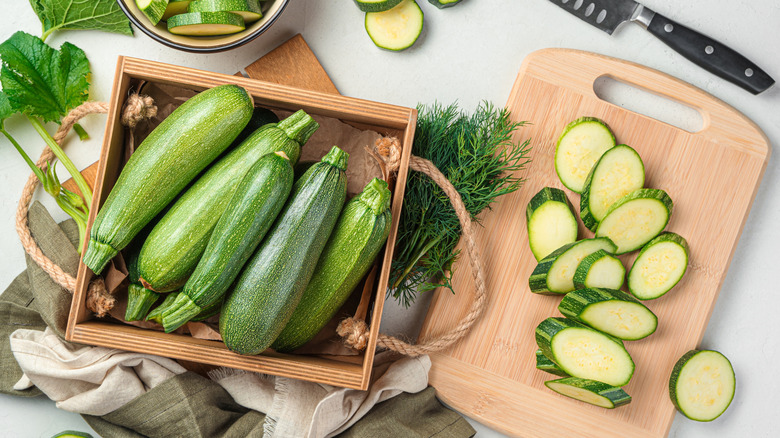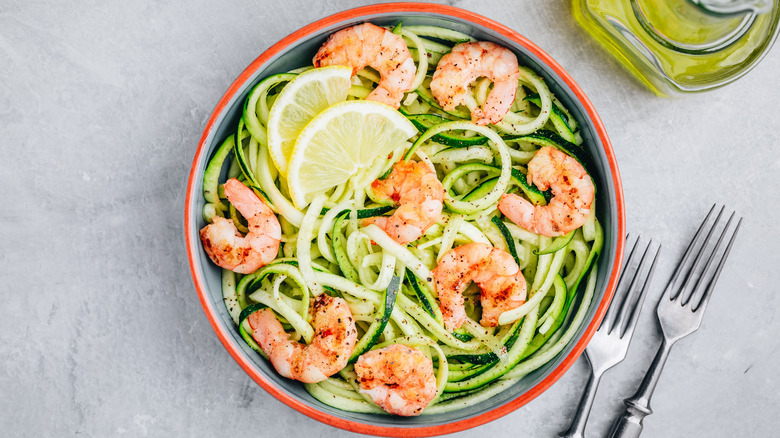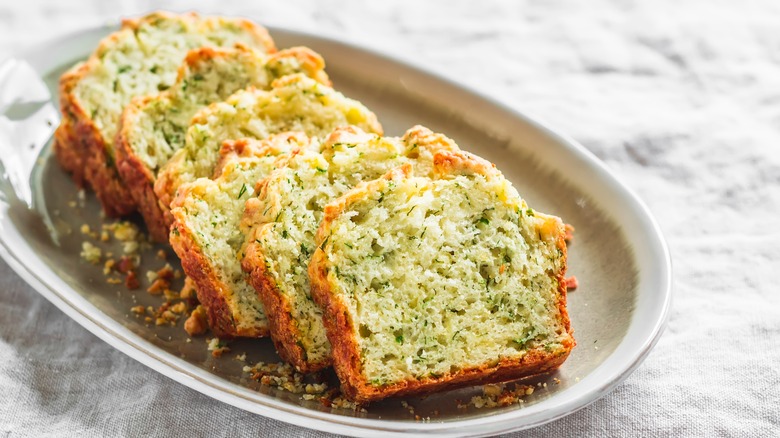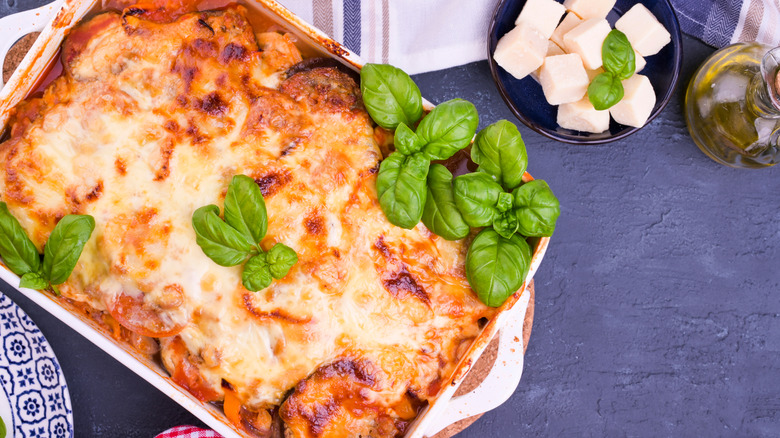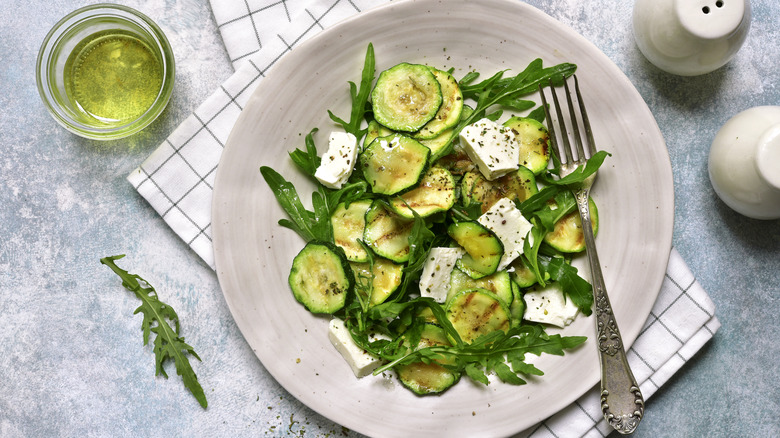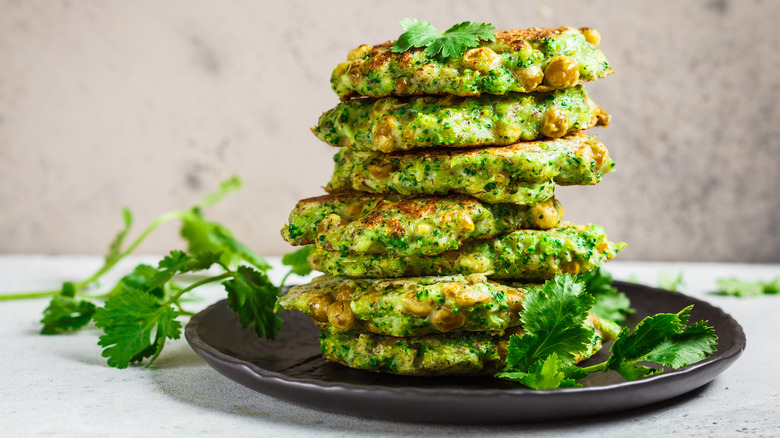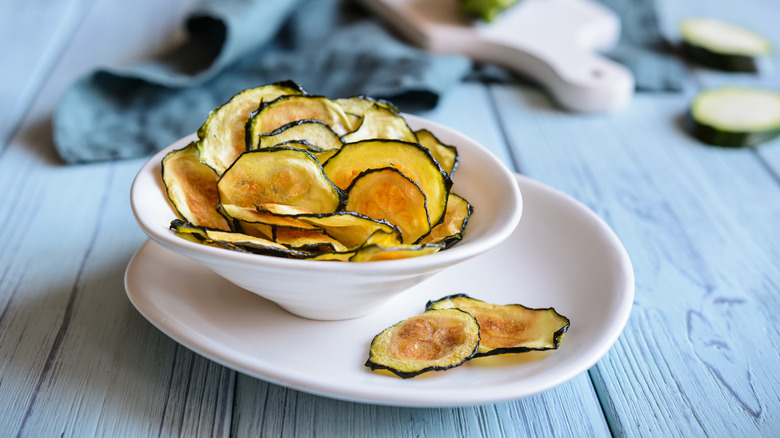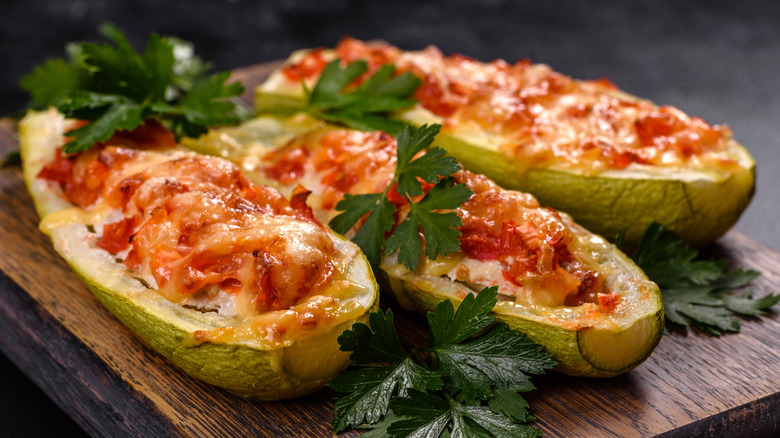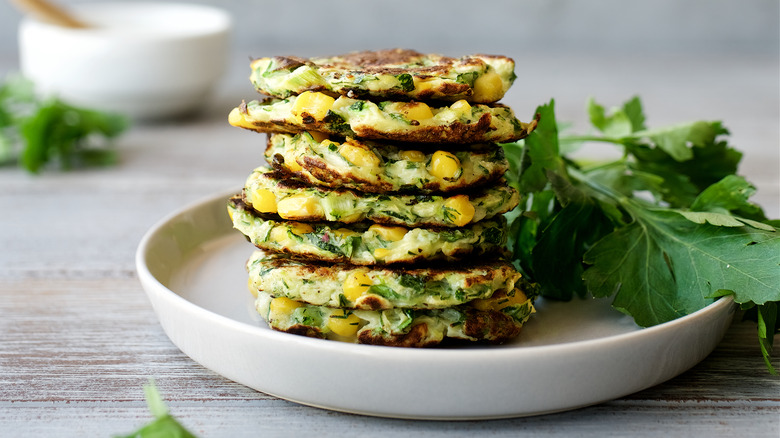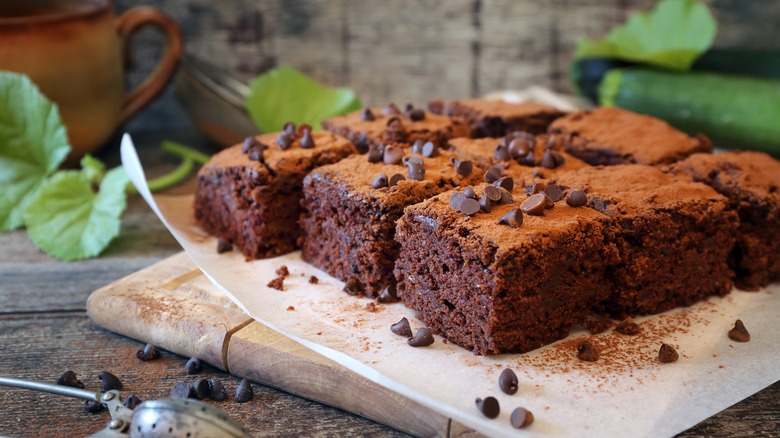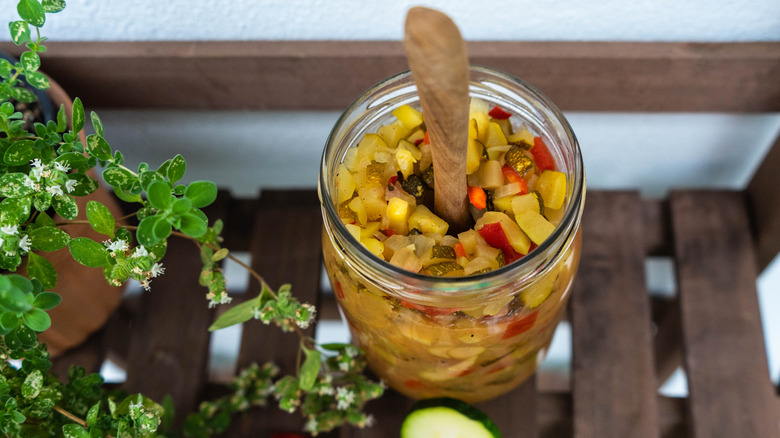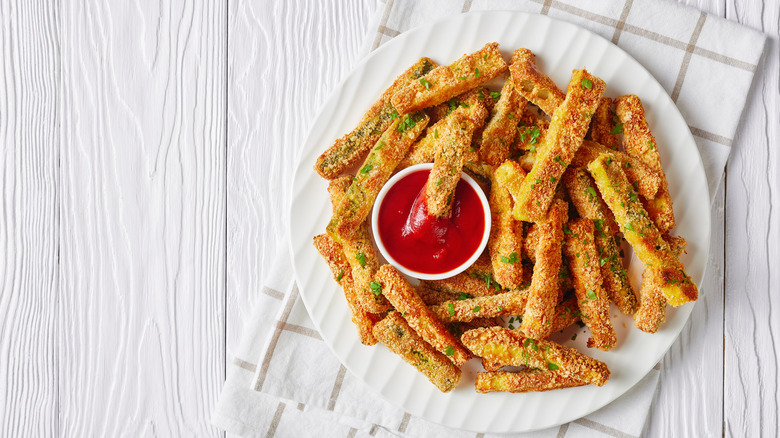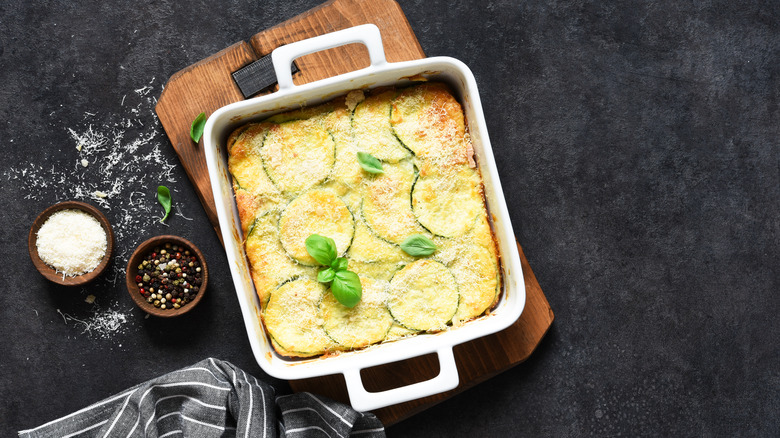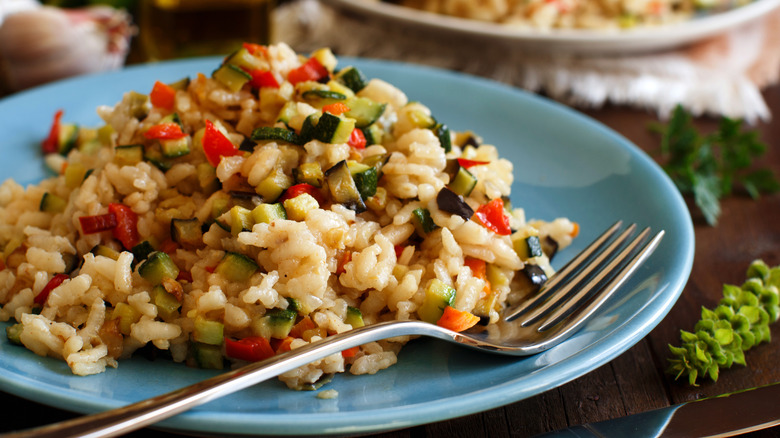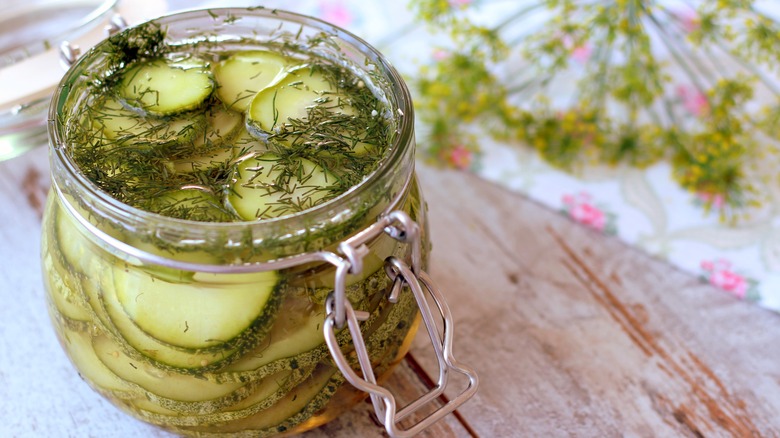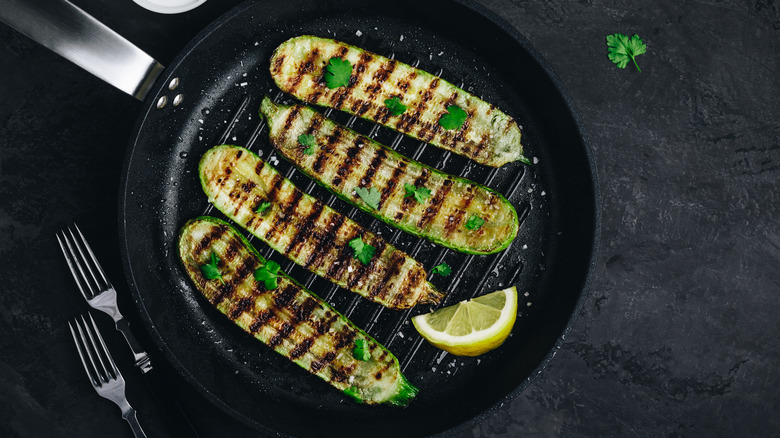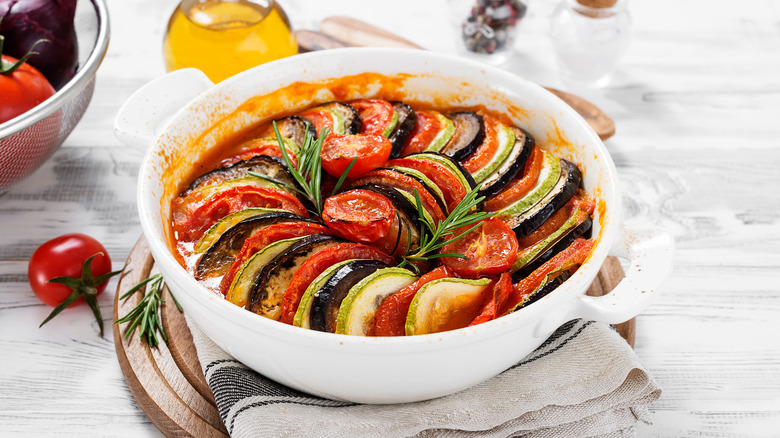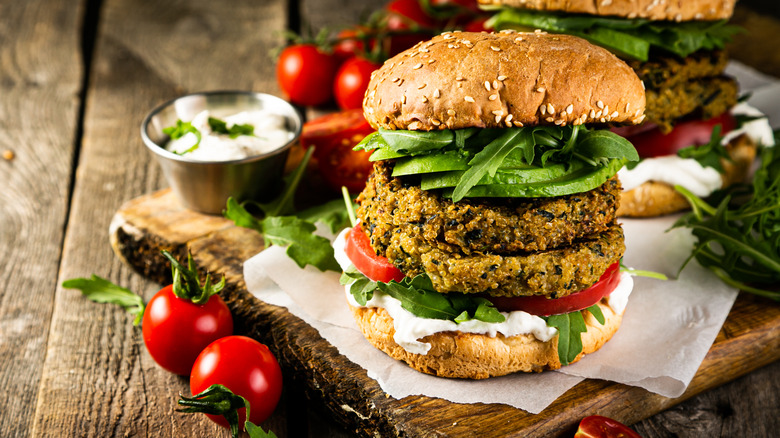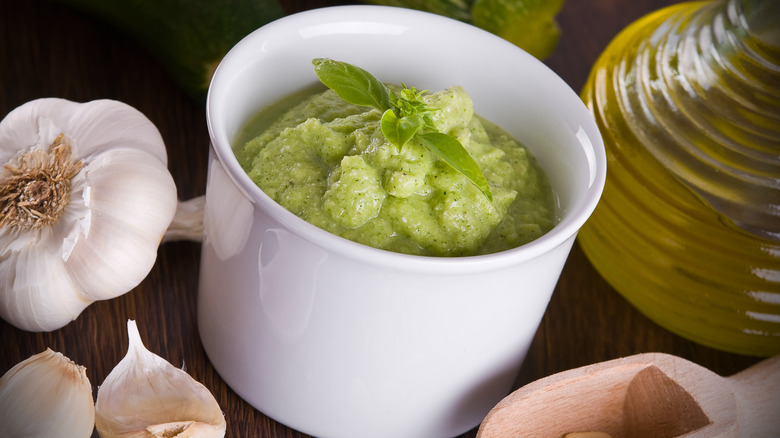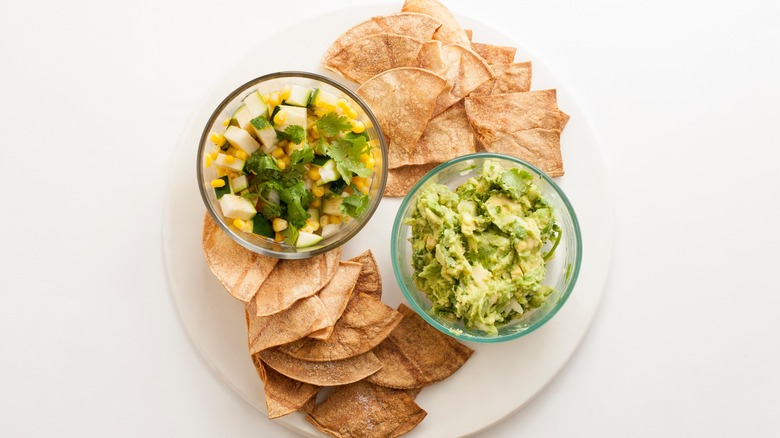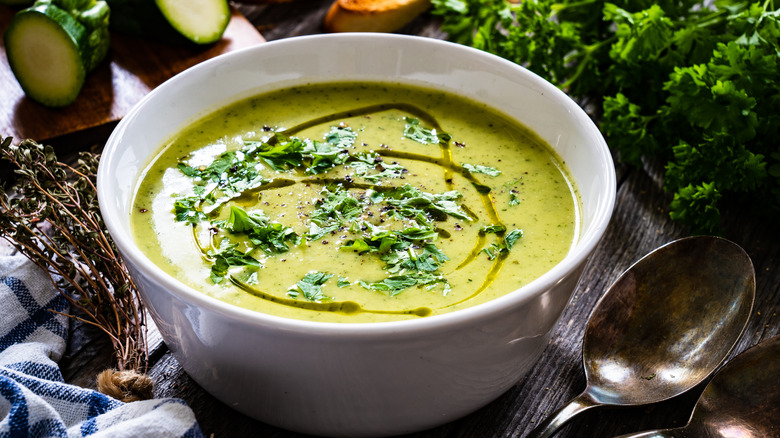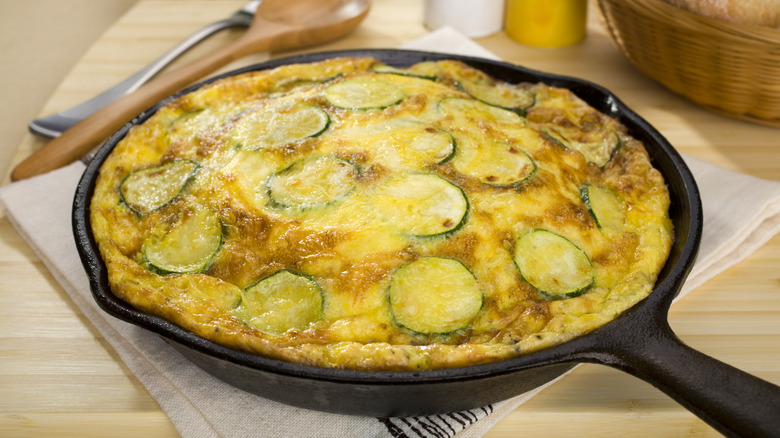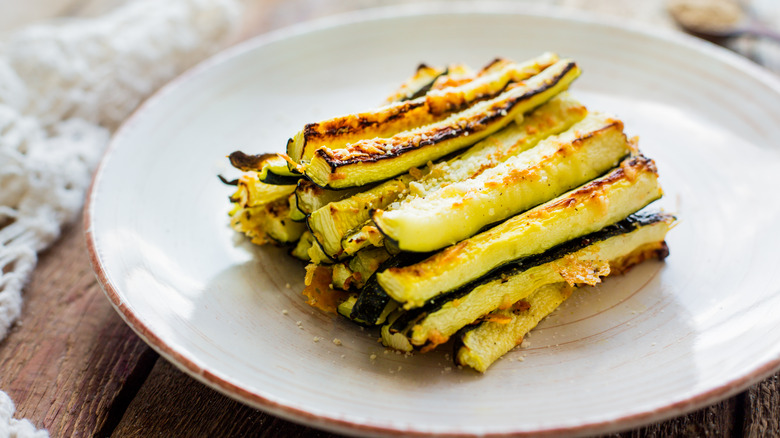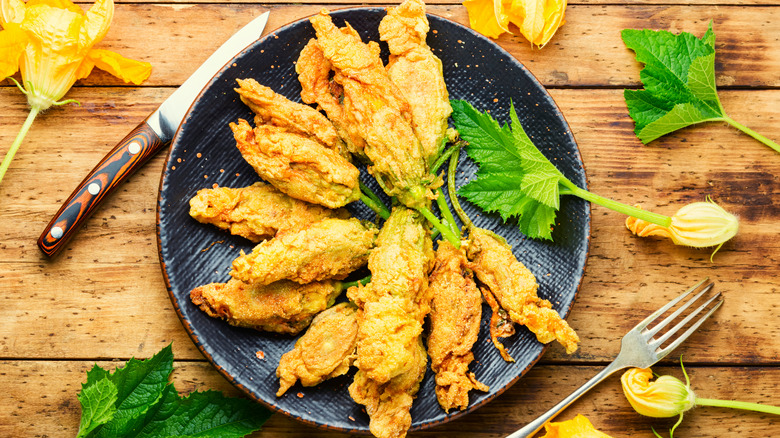23 Unexpected Ways To Cook With Zucchini
The humble zucchini, or courgette, is a summer squash that cooks like a vegetable but is a fruit. This member of the Cucurbitaceae family is consumed in its immature format but can grow to a size of up to three feet in length, as many of us can attest to when our zucchini plants begin to get away from us during the summer. Although most squashes originated in the New World, the zucchini we know today originated in the 1800s in Italy, per Healthline.
Zucchini has long been an integral ingredient in folk medicinal traditions. Indeed, its nutritional profile is impressive, with high levels of antioxidants, fiber, vitamins, and minerals. It is high in cancer-fighting compounds and nutrients like lutein, zeaxanthin, and beta-carotene. The latter are integral to bone health and in staving off the onset of age-related macular degeneration.
As chefs, we love its incredible versatility. When armed with the proper tools and techniques, this mild-flavored fruit becomes something spectacular. From savory appetizers, soups, salads, and entrées to sweet baked goods, breakfasts, and desserts, here are some of our favorite ways to transform the zucchini at any stage of its development.
1. Zoodles
Zoodles, or zucchini noodles, are all the rage, with many people opting for low-carb alternatives to items like pasta. However, there are some pitfalls to avoid. First, make zoodles yourself rather than purchasing pre-made ones at the store. Spiralizers are readily available and inexpensive to add to your kitchen arsenal. When you make zoodles, dry them thoroughly before using them to avoid them becoming soggy. And never overcook them, or they will disintegrate. They only require a few seconds of heat to warm them through. Whether you use them cold in a salad or warm in a mock pasta dish, always incorporate plenty of acidic ingredients, and opt for lighter dressings or sauces that won't drown the zoodles. And for a hint of umami flavor, consider garnishing with a strongly flavored cheese like feta or freshly grated parmesan.
2. Quick Breads
There is a reason people have long utilized zucchini in quick bread recipes — moisture. As the shredded zucchini begins to heat through in the oven, it releases water, which creates steam, which helps to tenderize your quick bread. They are an ingenious solution to a fairly common problem with quick bread — they tend to dry out in the oven and become crumbly. It is also a fabulous way to use up zucchini that has matured beyond the point where it is tender enough for a salad or a stir fry. While some recipes call for peeling the zucchini before shredding, consider leaving the peel intact for nutritional value and texture. Additionally, adding flavorings like spices, extracts, and chocolate to the zucchini bread recipe will tame the residual squash-forward flavor.
3. Lasagna
In another variation of creating a low-carb solution to one of the ultimate comfort foods — lasagna — the zucchini comes to the rescue as a mock noodle. When making a zucchini lasagna, you will want to utilize zucchini that are about 1 ½ inches in diameter for the ideal texture that both holds together and becomes tender. We recommend grilling or roasting the sliced zucchini before adding it to your lasagna. Doing so will remove the excess moisture that would drown the dish and caramelize the natural sugars, giving them a delightful nutty flavor. And while many lasagna dishes use ground beef as the star, consider shaking things up by combining meats. In so doing is an opportunity to use game meats, like ground venison, combined with a mild Italian sausage for added flavor and fat.
4. Salads
It may go without saying that eating zucchini in salads is delicious, but it bears mentioning. The key to using zucchini for salads is selecting younger zucchini that are less than one inch in diameter. These tend to be sweeter, have fewer seeds, and have a milder flavor. You can chop, slice, or turn them into ribbons using a vegetable peeler to cut around their cores. When using them raw, we don't recommend peeling them. The peels have great texture and help to hold the zucchini together, particularly when coated with an acidic dressing. Now is a great time to incorporate fresh herbs, like dill or fennel fronds, for the brightness of flavor. We also recommend using your arsenal of finishing salts to help accentuate the natural flavors of the zucchini. A Hickory smoked sea salt, bacon salt, or truffle-infused salt will add umami to your salad.
5. Fritters
When thinking of fritters, what comes to mind is a crab cake or potato latkes. However, shredded zucchini yields a delicious variation. The key is curbing the moisture of the zucchini, which can easily make the fritters soggy, causing them to fall apart when fried. Regardless of what kind of binder you use, you will need binding. Flour or bread crumbs will work, but you may consider using alternatives like cornmeal or nut flour. These will give fritters a nice flavor, and they are gluten-free. Another way to reduce the moisture is to place the shredded zucchini into a colander set over a bowl, toss it with a teaspoon of salt, and allow it to sit for approximately 30 minutes. Dry the shredded zucchini with paper towels before mixing your fritter batter.
6. Chips
Zucchini chips are a healthy alternative to other salty snacks, but they're also delicious and addicting in their own right, as well as deceptively simple to make. Slice the zucchini into ¼-inch thick circles. Place these coins onto a baking sheet lined with paper towels and salt them evenly. Cover with another layer of paper towels and allow them to sit for 30 minutes. Once you dab off excess moisture, you can either deep fry or pan-fry the chips in oil. You will want an oil that can tolerate high heat, like grapeseed, canola, or coconut oil. Fry the chips until golden brown, and transfer them to a baking sheet lined with paper towels to drain any excess fat. Toss the chips with freshly ground pepper, garlic powder, smoked paprika, and some finely minced Italian parsley.
7. Stuffed
Get creative with your meals by stuffing zucchini with a myriad of fillings. We recommend using teenage zucchini an inch and a half in diameter. To hollow out the zucchini, use a melon baller to scoop out the seeds. We also recommend slicing a thin layer of the skin off the bottom half of each zucchini boat to create a flat surface that prevents rolling around in your baking dish. Our favorite recipe is a play on a classic Imam Bayildi, which translates to "the imam fainted." The story goes that the Imam fainted when he tasted this dish because it was so delicious. Typically it is made with eggplant, but zucchini works just as well. The squash gets filled with caramelized onions and tomatoes seasoned with copious quantities of garlic, herbs, and spices.
8. Pancakes
Similarly to quick bread, shredded zucchini added to your favorite pancake recipe increases its nutritional value and creates moist, delectable pancakes. The key is not overdoing it, or the pancakes will not cook through. Our favorite zucchini pancakes recipe uses about ½ cup of shredded zucchini for every cup and a half of flour. The zucchini gets added along with the wet ingredients, which include buttermilk. The acidity in buttermilk reacts with the baking powder in our recipe to create lots of air bubbles, which will help make your pancakes light and fluffy. And don't be shy to incorporate lots of flavorings, like pumpkin pie spice, vanilla extract, and a hint of lemon or orange zest. Be sure to serve these with real maple syrup for the best pancakes you've ever eaten!
9. Cake
We know carrot cake is controversial. You either love it or hate it. We love it, particularly when topped with copious amounts of real cream cheese frosting. The carrots in carrot cake add moisture and sweetness like zucchini does in a quick bread. The next time you have a bumper crop of zucchini that is getting a bit large, consider using them instead of carrots in a classic carrot cake recipe. Just remember that the zucchini may make the cake take a bit longer to bake through, so you will want to test it with a skewer or toothpick regularly to ensure it has fully cooked. And make sure you cool the cake before it is frosted, which will melt the cream cheese and tear the cake.
10. Relish
Who doesn't love a relish as a condiment for a hot dog, hamburger, or added to a tuna salad? While you can make relish out of cucumber, next time, try using some of those enormous zucchini from your garden. You can use them in a one-to-one ratio to cucumbers in a basic relish recipe. Just keep in mind that larger zucchini tend to have more seeds, so you should scoop out some of those seeds before chopping the zucchini to reduce any excess bitterness. Now would be a great time to mix things up by incorporating yellow squash, which you can substitute for zucchini in almost any recipe.
11. Fried
It's hard to argue with the deliciousness of frying virtually anything, which is no less true for the humble zucchini. We recommend using a zucchini approximately 1 ½ inches in diameter, which should be quartered lengthwise and then cut into two-inch-long segments. For flavoring, batter in flour seasoned with garlic powder, smoked paprika, salt, and pepper. Next, don't forget to season your egg batter with salt and pepper. And finally, give your bread crumbs some extra jive by incorporating a bit of freshly grated parmesan, salt, pepper, garlic powder, and smoked paprika. Always fry in oil suitable for high temperatures, like grapeseed, canola, or coconut oils. And make sure you use a thermometer to ensure the oil is at a consistent temperature. Once fried, drain your zucchini on paper towels to remove excess fat, and serve hot with lemon aioli.
12. Casserole
Casseroles are the ultimate comfort food. Whether it's a homemade macaroni and cheese, a layered potato casserole, or even a tuna noodle casserole, digging into a dish like this hot out of the oven soothes your soul. Adding vegetables to starchy casserole recipes adds nutrition without compromising flavor. It is a sneaky way of getting your family to eat more vegetables. Dice up your zucchini and sauté it with onions or other ingredients forming the base of your casserole. We highly recommend using a touch of freshly grated nutmeg in this application, as it'll add a depth of flavor that will make it pop.
13. Risotto
Risotto is a classic Italian favorite featuring Arborio or Carnaroli rice. This rice has a uniquely high starch content only coaxed out through the slow fastidious addition of warm stock accompanied by constant stirring. It is the ultimate exercise in patience and the health of joints in your wrist and elbow. You can add virtually any vegetable to a risotto, but since zucchini is a quintessentially Italian vegetable, it is the perfect ingredient to join this luxurious dish. We suggest sautéing chopped zucchini along with the onions and garlic at the beginning of the cooking process so that most of the moisture in the zucchini has cooked off before adding the rice. Don't forget to garnish this dish with freshly grated parmesan cheese.
14. Pickled
Pickling is the ultimate solution for what to do with copious quantities of vegetables. Canning or freezing zucchini are suitable ways to preserve it, but these compromise the texture too much for use in anything other than soups. Pickling, on the other hand, enables you to extend the shelf-life of zucchini without destroying its delicate texture. Pickled zucchini is ideal on sandwiches, added into a homemade tuna or chicken salad, or even to make your remoulade sauce for topping crab or salmon cakes. It is also great added to Asian stir-fries for a little extra kick of flavor. And try stirring a bit of pickled zucchini into your scrambled eggs for a twist the next time you make breakfast.
15. Grilled
Grilling vegetables is a fantastic way to transform their flavor and texture. The high heat enables the natural sugars in vegetables to caramelize, resulting in a nutty flavor and meat-like texture. With zucchini, we recommend two ways of grilling. You can slice them into circles about ½ inch wide, throw them onto the grill, and then season them for a quick side dish. Alternately slice the zucchini vertically into approximately ¼-inch-thick sheets that can be lightly grilled and used as wrappers for a quick appetizer. Our favorite filling is herbed goat cheese seasoned with salt, pepper, lemon zest, and an assortment of finely chopped herbs. Serve these at a party for the ultimate one-bite amuse-bouche that is sure to please your guests.
16. Ratatouille
While the word ratatouille may conjure images of a rat dressed in chef's whites whipping up culinary creations, the term refers to a delightful summer dish native to the Provence region of France. The stew of vegetables seasoned with garlic, herbs, herbes de Provence, and a tomato sauce takes advantage of whatever fresh vegetables happen to be growing. The most common vegetables used are eggplant, peppers, and summer squash. Not only is this a relatively simple dish to execute, but it is also aesthetically stunning and rife with colors. This meal can be eaten as a side dish accompanying some delicately grilled fish or served as a light lunch with plenty of crunchy bread to dip into its luscious juices.
17. Added to burgers and meatballs
Chefs often use zucchini to create vegetarian or vegan burger and meatball recipes. It also can be used in a classic full-meat variation of a burger or meatball. Why corrupt a good beef patty or pork meatball with shredded zucchini? It's simple — moisture. Ground beef and pork can dry out when not cooked medium rare, which is typically ill-advised with ground meat of any kind. Adding shredded zucchini into the ground meat can help release much-needed water, tenderizing it as the hamburger patties or meatballs cook. The key is not overdoing it and starting your burgers or meatballs on high heat so that you sear the exterior well, ensuring they hold their shape without falling apart.
18. Pesto
Pesto, which means "to pound," is a classic Genovese sauce typically made using fresh basil, pine nuts, parmesan cheese, garlic, and olive oil. Pesto variations are common, incorporating different nuts, cheeses, and herbs of all types. Adding shredded zucchini to the mix makes good sense. Replace half of the basil in your favorite recipe with shredded zucchini, and voilà! You can toss this over pasta, add it to scrambled eggs, use it to level up your grilled cheese sandwich, or mash it into potatoes. The possibilities are endless. And if you don't eat it all or want to make a big batch, fill ice cube trays with excess pesto and freeze for the perfect individual-sized portions you can thaw anytime you are craving something bright and flavorful.
19. Salsa
While most people think of tomatoes when they think of salsa, there's no reason that salsa cannot contain other vegetables. Adding corn or black beans to salsa is quite common. Why not expand your definition of salsa by adding grilled or roasted zucchini? Start with a zucchini that is between one and two inches in diameter. Quarter the zucchini lengthwise and cut it into two-inch pieces. Drizzle liberally with olive oil and season with salt and pepper. These can either be thrown onto the grill for a quick char or placed on a baking sheet and roasted for approximately 20 minutes at 425 degrees or until tender and caramelized. You can chop the cooled zucchini and add it straight into a traditional salsa or combine it with tomatillos for a zesty salsa verde.
20. Soup
We love making soup for a hearty, easy recipe to eat on a busy weeknight. You can whip up a large batch over the weekend to sip on all week or place your ingredients into a crockpot on low in the morning for a one-dish meal when you get home from work. Certainly, zucchini is a perfect addition to a classic Minestrone or even as a means of lightening up a meat or bean chili, but zucchini can be the star of a soup on its own. The key is to maximize the flavor of your zucchini by either grilling or roasting it and adding plenty of fresh herbs or spices to your soup. For the best texture, purée all the ingredients in a blender for a creamy bisque and garnish with crème fraîche or sour cream.
21. Frittata or quiche
Whether making an Italian frittata or a French quiche, zucchini is the perfect summer vegetable to include in your recipe. You can either use shredded zucchini or diced zucchini but always sauté it along with onions and any other vegetables that you are using to eliminate any excess moisture from the zucchini before adding the eggs. This process is even more critical with quiche, as the excessive liquid makes your crust soggy. We also recommend utilizing a cheese that melts well in our frittata or quiche, like shredded swiss, asiago, or Gruyère. Don't forget to season your eggs adequately. We typically add salt, pepper, garlic powder, smoked paprika, herbes de Provence, and freshly grated nutmeg. It's an extra step that will make all the difference between a good dish and a transcendent one.
22. Roasted
Roasting vegetables is one of the best ways of cooking without lots of fat and with maximum flavor. The high heat caramelizes the natural sugars in vegetables, giving them a robust, nutty, umami-laden flavor while retaining a nice chewy texture. It is particularly true for zucchini, which can get mushy when cooked due to its high moisture content. As far as seasonings are concerned, the sky's the limit. It all depends on your creativity and the spices in your pantry. And if you want to add extra flavor, try topping your hot roasted zucchini with freshly grated parmesan cheese. It's a delightful and easy side dish for a quick weeknight dinner.
23. Blossoms
We would be remiss in discussing cooking zucchini without addressing the use of squash blossoms in recipes. They are typically picked fresh in the morning and used that day. To clean them, gently reach into the center of the flower and pinch out the stamen or pistil to remove them. In Italy, squash blossoms get stuffed with ricotta cheese, freshly grated parmesan, lemon zest, garlic, and fresh herbs. They are then lightly breaded or dipped in a tempura-like batter before being fried. They can also be used as a topping on pizza, in frittatas, as a filling for a quesadilla, or as an addition to stews. Even though they are a flower, their flavor isn't overly floral. It has a mild, delicate sweetness redolent of a mature zucchini.
